
Is it bragging if you tell the world you are REALLY good at something? What if you broadcast it on your website or post about it on your Facebook page? What if you tell everyone you know that you have an AWESOME talent?
Here’s what I think. If you are boastful to the point of lifting yourself up above others just to make yourself look amazing, it’s not so good. BUT–if you really are AWESOME at something and you tell everyone you know for the purpose of helping others, it’s okay to tell the whole world.
That was my way of justifying my next statement. Here’s what I really want to tell you.
I am AWESOME at treating shoulder pain!
I’ve got a reputation around town for resolving chronic shoulder pain problems. I teach analysis and treatment of shoulder pain in my advanced graphing seminars. Heck, I even have a video related to acupuncture and the treatment of shoulder pain on YouTube.
Personal story #1: I’ve been treating shoulder pain for twenty years. I started out as a massage therapist, and then got my degree in acupuncture and Chinese medicine. I was pretty good at shoulder pain up to this point; but it wasn’t until I started working for Miridia Technology, utilizing AcuGraph and other treatment tools in my practice, that I became AWESOME at treating shoulder pain.
Here’s a question for YOU:
How AWESOME are you at treating shoulder pain?
I’ve got some of my personal tips and techniques to share.
1. Graph Analysis
Everyone has shoulder pain–whether it’s their chief complaint or they are coming in as a wellness patient for a tune-up. Shoulder pain just happens. You should be VERY good at recognizing shoulder pain on the graph and be able to comfortably explain your findings.
Here is a picture of a graph that SCREAMS shoulder pain.
The easiest way to talk to patients about what you see in the graph is clicking on the channel.
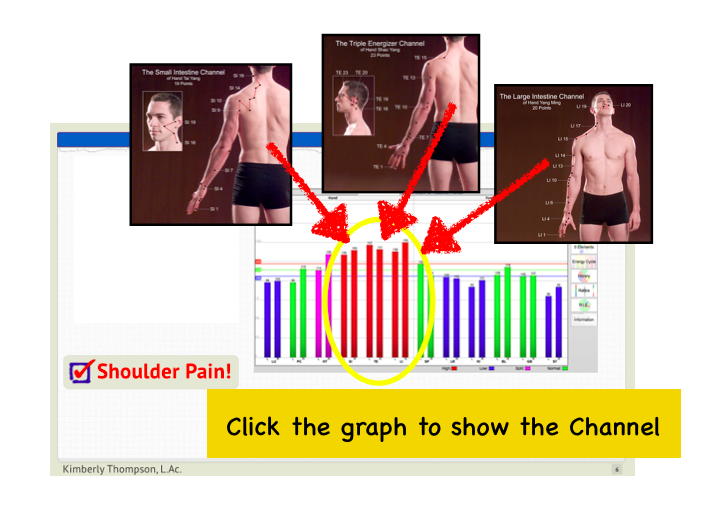 The Small Intestine, Triple Energizer and The Large Intestine channels all run right through the shoulder. I’ve been explaining my understanding of shoulder pain to patients with this tool for years. Patients love the visual, which makes explanations of acupuncture theory easy. I don’t have to tell them all about Blood Stagnation, Qi Stagnation or Damp. I simply click on the channel and show the patient where there is too much or too little energy flow in the pathway. Easy.
The Small Intestine, Triple Energizer and The Large Intestine channels all run right through the shoulder. I’ve been explaining my understanding of shoulder pain to patients with this tool for years. Patients love the visual, which makes explanations of acupuncture theory easy. I don’t have to tell them all about Blood Stagnation, Qi Stagnation or Damp. I simply click on the channel and show the patient where there is too much or too little energy flow in the pathway. Easy.
2. Tendinomuscular Pathways
Do you remember studying tendinomuscular pathways in college? I LOVED them!
Take a look at this picture.
Channel pathways are quite thin (like the first set of pictures, above), and run directly along the channel line. Tendinomuscular pathways on the other hand are thick (like the second set of pictures, above) and have larger coverage areas, many of which are not even specifically on the external meridian pathway.
Personal Story #2: My first “aha moment” with tendinomuscular channels came while I was a massage therapist working my way through acupuncture school. If I learned something new at college, I’d hang pictures and notes on the wall in my massage clinic so I could reinforce my understanding of channel pathways while massaging.
One day, shortly after learning tendinomuscular pathways, I was working the neck and shoulders, wondering if there was a better way to resolve the crazy knots I was pounding with my thumbs. I looked at the Large Intestine tendinomuscular pathway I had hanging on the wall and decided to divert my attention to points along the Large Intestine channel (giving my thumbs a bit of a break). After I worked them, I went back to resume work at the neck and shoulders. The knots literally melted like butter underneath my fingers. No deep tissue work. I simply had to touch them and they dissolved.
My world changed that day. Five minutes of working the channel saved me 30-45 minutes of deep tissue work in the neck and shoulder. I was amazed and patients were impressed.
If you work the points along the thin channel pathway, the thick tendinomuscular pathways open up and melt away. It’s not hard. Just palpate along the channel and treat areas of stagnation.
3. OTHER Favorite Points
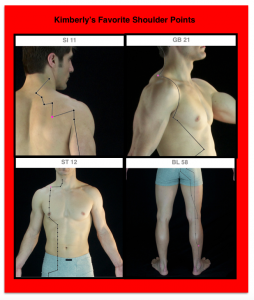 After treating the tendinomuscular points as stated above, I also add points such as:
After treating the tendinomuscular points as stated above, I also add points such as:
- Small Intestine 11: Opens the entire shoulder. Small Intestine 11 is great because it also relaxes the subscapularis muscle underneath the scapula. (You know, that deep area of pain that you can’t quite touch with acupuncture needles or massage?)
- Gallbladder 21: Opens the shoulder and pushes energy down the Gallbladder channel.
- Stomach 12: Did you know that Stomach 12 is the crossing point for all of the Yang Meridians. Treating this single point effectively treats all the yang channels–all of which traverse right through the shoulder.
- Bladder 58: This is the Great Luo point for the Bladder channel. It helps relax the entire back.
4. Auriculotherapy
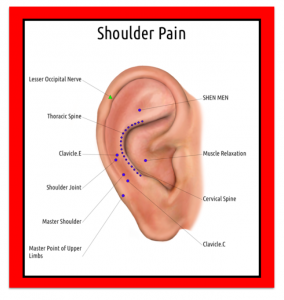 Here’s where you seal the deal.
Here’s where you seal the deal.
After you are done with treatment, ask the patient to sit on the side of the table and “recreate” the pain in the neck and shoulder. Usually they say something like this: “Wow, I’m doing so much better. I only have this little are of lingering pain.”
I then pull out my Auriculo 360 Shoulder Pain Protocol and treat the ear that correlates to the pain (right-sided pain/right ear; left-sided pain/left ear). I find the electrically active points with my Stimplus Pro and treat them. Next, I add ear seeds to the points I have treated.
THEN–I have the patient recreate the pain again. Their typical response is this: “W-O-W…. It’s GONE! I can’t believe you just did that. You are AMAZING!”
Here’s a video showing how this technique works: Using the Stimplus Pro to treat Shoulder Pain.
Now you know my secrets to being AWESOME at treating shoulder pain. Really, it comes down to experience and having the right tools.
1. AcuGraph Analysis
2. Auriculo 360
3. Stimplus Pro
The truth is, I’m not the only one AWESOME at treating shoulder pain. People all over the world stop me when I’m traveling and share the success they experience treating patients with our tools.
If you’ve got the right tools, you can be AWESOME too!
Here’s another tool that can help you.
 Want more Patients? Then grab this FREE PDF:
Want more Patients? Then grab this FREE PDF:
How to Create a Steady Stream of Profitable Wellness Patients!
Also, I’d love it if you’d share your thoughts on this blog post about YOUR shoulder pain experience. When we share what we know, EVERYONE can be awesome! I look forward to hearing your thoughts.
Talk to you soon!
~Kimberly

.
Kimberly Thompson, L.Ac.
Acupuncture Research Analyst
Miridia Technology

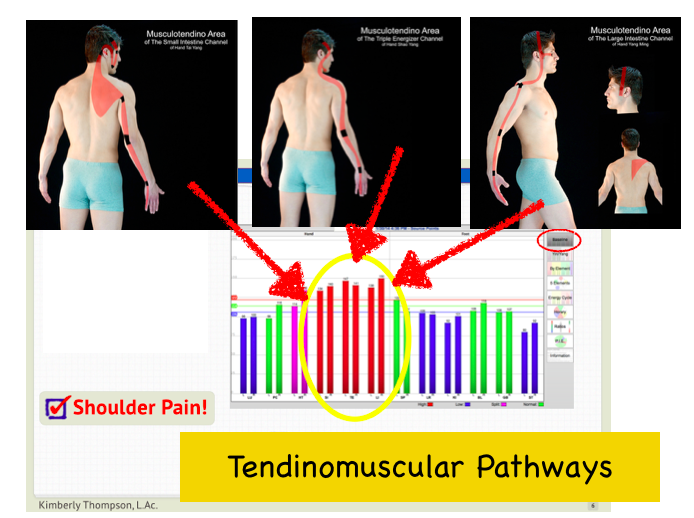
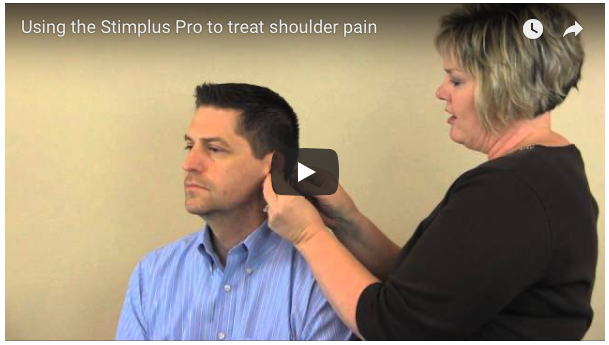

Thanks for sharing awesome information
very good it is useful in modern diagnosis
i like that you mention tendinomuscle channels i do not think about them when treating pain, its a good reminder.